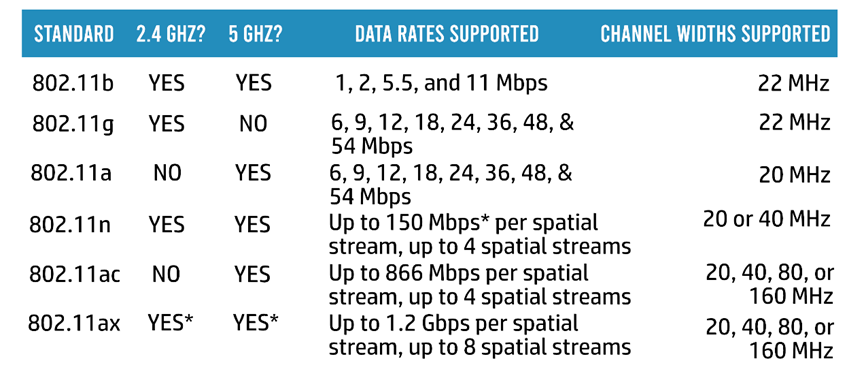To provide wireless communication that works, an Access Point and any client device associated with it must use wireless mechanisms that are compatible. The IEEE 802.11 standard defines these mechanisms in a standardized fashion. Through 802.11, RF signals, modulation, coding, frequency bands, channels, and data rates all come together to provide a robust communication medium.
The IEEE 802.11 standard is a collection of technological advances that have been produced over time. The initial 802.11 standards allow up to 2 Mbps on only the 2.4-GHz frequency band, and each incremental breakthrough is defined by an amendment to the standard that is designated by a one or two-letter suffix to “802.11.” New coding algorithms were implemented to 802.11b that uses (Direct-Sequence Spread Spectrum)to enhance throughput to 6 Mbps. 802.11a included 5-GHz capability as well as Orthogonal Frequency Division Multiplexing (OFDM) coding techniques that boost speed to 54 Mbps. The 802.11g standard brought OFDM from the 802.11a standard to the 2.4-GHz range. 802.11n included a number of high-throughput enhancements that increased throughput by about tenfold, allowing high-end enterprise access points to attain signaling throughputs of 450 Mbps.
Similar to how people follow etiquette and politeness rules to communicate with others, wireless devices do the same. They must follow a set of wireless standards or protocols, known as IEEE 802.11, to wirelessly communicate with other devices.
The WiFi standards were created by the Institute of Electrical and Electronics Engineers and are certified by the Wi Fi Alliance.
The goal is to create a better wireless LAN experience for the users. Therefore, these standards dictate the data throughput, range, and the use of frequency bands to achieve that goal.
IEEE 802.11 Common Amendments
IEEE 802.11 describes a set of standards that define wireless LAN communication (wireless local area networks, or Wireless LANs). Consumers refer to the wireless technology behind 802.11 as Wi-Fi. IEEE 802.11 is governed by the IEEE, specifically the IEEE LAN/MAN Standards Committee, as the name implies (IEEE 802).
Every step in the 802.11 evolution involves a standard amendment that defines items such as modulation and coding techniques used to transmit data over the air. 802.11 has progressed with the advancement of 802.11b and 802.11g in the 2.4 GHz band, with maximum data rates of 11 Mbps and 54 Mbps, respectively. Each of these changes introduced more complicated modulation mechanisms, resulting in higher data rates.
It is important to note that the highest data rates for 802.11b and 802.11g are 11 Mbps and 54 Mbps, respectively, and that both use a 22 MHz channel width. Using a 20 MHz channel, the 802.11a amendment added similar capabilities to the 5 GHz range.
Throughput is a measurement of how many units of data a system can process in a given period of time. It is used to describe a wide range of systems, from computer and network distribution system to business.

IEEE 802.11n
In 2009, an amendment was published in an attempt to increase wireless LAN performance to a theoretical maximum of 600 Mbps. The amendment was unique in that it defined a number of additional high throughput (HT) techniques that can be used in either the 2.4 or 5 GHz bands.
IEEE 802.11ac
802.11ac is a very high throughput (VHT) wireless standard that can only operate on the 5 GHz frequency spectrum. The table above shows that the maximum data rate is 3.5 GHz, although this can only be achieved if all available features are used and RF circumstances are suitable. There are so many different combinations of 802.11ac has roughly 320 distinct data speeds depending on modulation and efficiency settings!
Up to 802.11ac, Wi-Fi standards were based on the idea that only one device should be connected at a time. A device can request air time in order to data transfer to other devices.
IEEE 802.11ax
The 802.11ax amendment, also known as Wi-Fi 6 or high-efficiency wireless networks, intends to shift the focus by allowing numerous devices to broadcast at the same time. This is especially significant in locations where there are a lot of competing wireless routers devices in terms of broadcast time and throughput.
802.11ax uses more complicated and sensitive modulation and coding algorithms than 802.11ac, producing data speeds that are nearly four times faster. Better transmit power regulation and BSS marking or “coloring” approaches can help to avoid interference between neighboring BSSs. 802.11ax also employs OFDM Access (OFDMA) to schedule and govern wireless medium access, with channel air time provided as resource units that can be used by numerous wireless devices at the same time.
Download our Free CCNA Study Guide PDF for complete notes on all the CCNA 200-301 exam topics in one book.
We recommend the Cisco CCNA Gold Bootcamp as your main CCNA training course. It’s the highest rated Cisco course online with an average rating of 4.8 from over 30,000 public reviews and is the gold standard in CCNA training:
